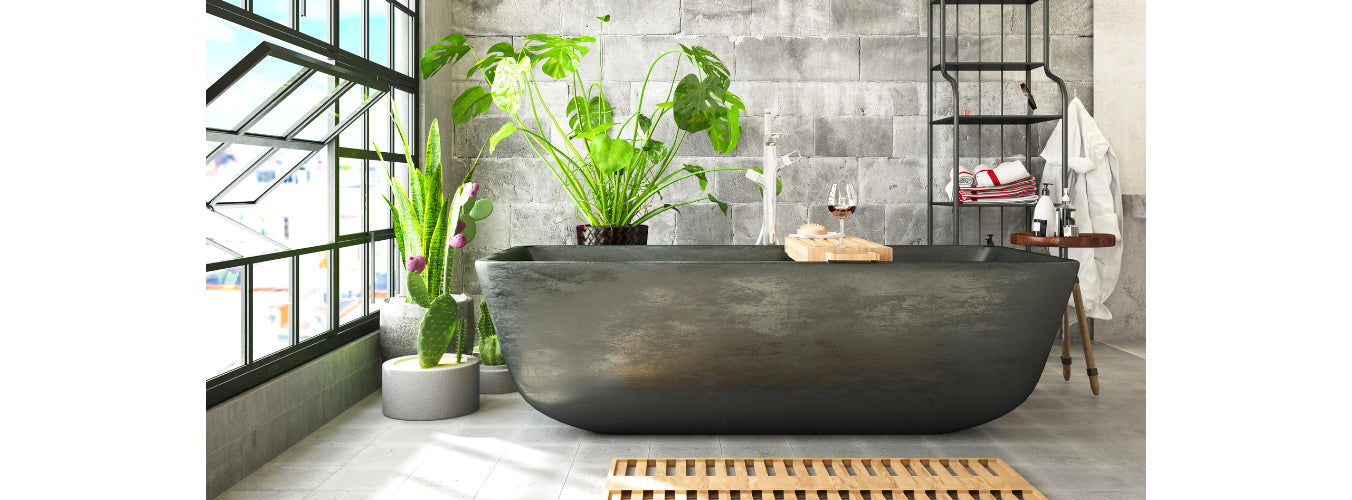Get PRO Pricing
Get [PRO] Pricing

Homeowners don’t have to embrace the jungle oasis trend to appreciate the look of plants in their homes. Whether they choose exotic succulents, draping spider plants, or spiky snake plants, they can enjoy the pop of color they add to the room. Stripy leaves, vibrant flowers, and winding stems can slide into any number of decors, from the bathroom to the bedroom.
For many people, the bathroom is a personal sanctuary, a place where they begin and end their day. Bringing sunlight and plants into the room can add a soothing touch for these moments. In fact, houseplants may feel right at home in the bathroom. They’ll be close enough to water that it can be easier to remember to water them, and the humidity that builds up in the room when someone showers helps keep the plants healthy.
With a little thought and careful planning, it’s possible to bring plants into the bathroom in a way that honors the room’s design and highlights the features that give it character. Best of all, this doesn’t apply only to homeowners. Renters can also take advantage of these tips for bringing natural elements into your home without getting special permission from the landlord.

Of course, it helps to start with plants that will be able to survive in the space. Hardy plants that don’t require a lot of light tend to work well in bathrooms. Tropical plants like begonias and bromeliads should enjoy the humidity in the room. Adaptable plants like the Chinese evergreen and what’s called the cast-iron plant tend to forgive their humans when they forget to water them. Other plants to consider include snake plants, pothos, peace lilies, and spider plants. Succulents are easy to care for, but they don’t always tolerate humidity well.
A bathroom with plenty of natural light can accommodate more species of plants. However, water and light should not be the only considerations for choosing plants. It’s also important to consider the nature of the plant. Some plants have thorns and spikes to protect them, and dodging spikes doesn’t support the relaxing environment of the bathroom. Plants that propagate easily may produce too many new plants that the homeowner must throw away or plant somewhere else around the house.

The planters holding the plants serve a dual purpose. They give the plant a home and add a decorative touch to the space. The planters may complement or contrast the existing colors in the room, including the shower and sink fixtures. Start by asking if the room feels cool or warm. Warm shades tend to have red undertones pair, and cool shades have blue undertones. Look at the fixtures. Oil rubbed bronze, copper, and polished brass have warm undertones. Polished nickel and chrome are cool.
Complementary colors have similar undertones. For example, if the bathroom has oil rubbed bronze fixtures, look for planters in shades of red and orange to bring out the warmth in the room. Planters in cooler hues like purple and blue help bring out the coolness in a room with polished chrome fixtures. To contrast the colors, try pairing warm fixtures with cool colors (think polished brass with a bright blue) or mixing cool fixtures with warm planters (like chrome with a sunny yellow).

Both fixtures and plants can be the focal point in the room, so carefully consider where to place them. A plant with vine-like stems, like pothos or ivy, spreads out from the planter and can wrap around a clawfoot deck, hiding its vintage charm. Hanging these plants from the ceiling gives them more room to grow. Place them in the shower where they can highlight a dramatic Roman tub faucet.
Plants can also add balance to the sink and vanity, places that don’t always get much attention in the bathroom. Snake plants intentionally positioned under a pedestal sink can hide unsightly pipes while directing the eye up to the stunning Victorian faucet in bold black. An orchid placed between a pair of matching vessel sinks can break up blank wall space, tie the pieces together, and add texture and height that highlights the space as a focal point.
Plants can play up or down the visible textures in bathroom fixtures. Like with colors, it’s possible to complement or contrast these textures. A spiky fern or ivy can make the smooth, shiny surface of polished brass or chrome pop. It also can blend in with the muted surface of brushed nicked. The shiny leaves on a cast-iron plant or orchid mimic the mirror-like finish of chrome or blend with the slick surface of oil rubbed bronze. They can add contrasting texture to subdued black matte, softening the color’s depth, so it doesn’t dominate the room.
When considering texture, it also helps to account for height. The spiky leaves of a snake plant grow straight up, adding vertical lines to the space. They can create an interesting backdrop for a standard faucet or flank a wall mounted tub faucet to add a touch of drama. In small rooms, it may be more practical to add some repetition with a series of small potted plants placed along the back of the vanity or along the tub. Vine-like plants direct the eye around the room in a way that simultaneously highlights and diminishes elements in the room.
Create a space you love, and turn your bathroom into a private spa or sanctuary. The bathroom faucets and shower accessories at Kingston Brass come in an array of styles, colors, and textures that allow you to customize the space. Explore the selection to spark creativity, and begin dreaming of the way you can transform your bathroom.
Plants ins a space
